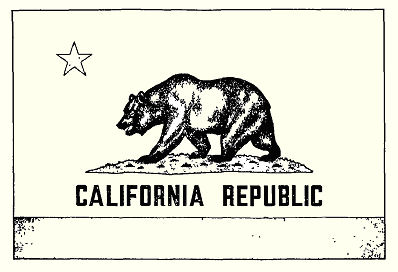
HOME
INTRO
SYMBOLS
ALMANAC
ECONOMY
GEOGRAPHY
STATE MAPS
PEOPLE
FORUM
NEWS
COOL SCHOOLS
STATE QUIZ
STATE LINKS
BOOK STORE
MARKETPLACE
GUESTBOOK
CONTACT US


Tweet
Double click on word for definition.
California State Animal
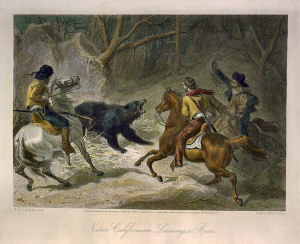
Native Californians Lassoing Bear
Credit: Library of Congress
We may be wrong, but if you've heard of the State of California, we would bet that you've heard of their official state animal, the California grizzly bear (Ursus californicus).
California is awash in grizzly bear emblems, beginning with its famous Bear Flag, hastily constructed during a minor 1846 confrontation between Americans and Spanish officials at Sonoma, California that over time became known as the Bear Flag Revolt.
The California grizzly bear, a large and very powerful carnivore indeed, thrived in the valleys and the coastal slopes of California at that time.
The California grizzly's relationship with the settlers, who poured into California, particularly after the discovery of gold in 1848, was interesting.
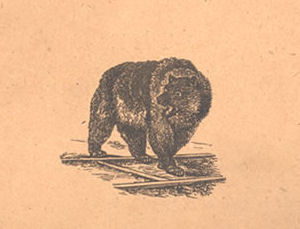
Bear Logo for Overton Monthly
On one hand, this ferocious animal was a threatening presence, killing livestock and generally interfering with the lives of the people pouring into the state. On the other hand, there was admiration for the bear's power and tenacity.
In the first issue of his journal The Overland Monthly and Out West Magazine devoted to the development of the country, publisher Bret Harte wrote about why he chose a California Grizzly Bear as the publication's logo.
"The bear who adorns the cover may be 'an ill-favored' beast whom 'women cannot abide,' but he is honest withal. Take him if you please as the symbol of local primitive barbarism.
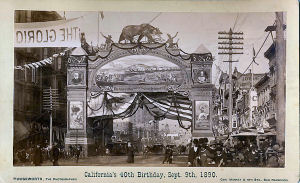
California's 40th Birthday, Sept. 9, 1890
Corner Market & 4th Street, San Francisco
"He is crossing the track of the Pacific Railroad, and has paused a moment to look at the coming engine of civilization and progress - with a prodigious shrieking and puffing - and apparently recognizes his rival and his doom. And yet, leaving the symbol out, there is much about your grizzly that is pleasant. The truth should however be tested at a moment when no desire for self-preservation prejudices the observer. In his placid moments he has a stupid, good-natured, grey tranquility, like that of the hills in midsummer.
"I am satisfied that his unpleasant habit of scalping with his forepaw is the result of contact with the degraded aborigine, and the effect of bad example on the untutored ursine mind.
"Educated, he takes quite naturally to the pole, but has lost his ferocity, which is perhaps after all the most respectable thing about a barbarian. As a cub he is playful and boisterous, and I have often thought was not a bad symbol of our San Francisco climate. Look at him well, for he is passing away. Fifty years and he will be as extinct as the dodo or dinornis."
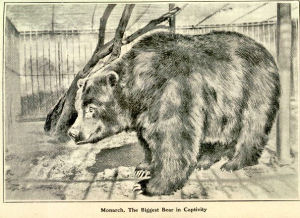
Monarch, The Biggest Bear in Captivity
Bears I Have Met - and Others by Allen Kelly
Unfortunately, grizzlies and civilization did not mix well and it's estimated that by the early 1920s all of the California grizzly bears had either moved from the state or been tracked down and killed. It's reported that the last grizzly bear in California was shot by a Fresno County rancher in 1922.
Yet the man does not live who can say truthfully that he ever was eaten by a bear. ¹
The California Bear Flag became the de facto state flag when California joined the Union in 1850 even maintaining its description of the state as the "California Republic." But it wasn't until 1911, after adopting a state flower, that the California Legislature finally got around to making the Bear Flag the official flag of the state by law.
Adoption of the California State Animal
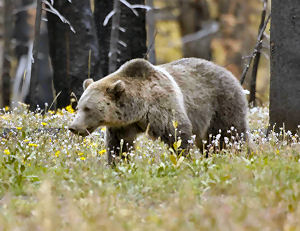
Grizzly Bear Ursus arctos horribilis
Photograph: USFWS photo by (Terry Tollefsbol)
Forty years after the flag was adopted by law, a state purchasing agent, in preparation to purchase new flags for the state, thumbed through the law looking for exact specifications. He couldn't find any.
To make a long story short, current versions of the flag in use were found lacking and inconsistent. There were complaints that the animal on flags often had the look of a wolf or a pig rather than a grizzly bear. It was determined that an exact set of specifications would be defined and put into the force of law.
Indeed, a detailed set of specifications was created for section 420 of the California Government Code and remains in effect today.
These detailed specifications were proposed with the introduction of Assembly Bill No. 1014 (AB1014) in the California Assembly in January of 1953.
Section 420, the specification for the flag, was not the only section of the Government Code addressed by AB1014 though. Section 422 was amended and section 425 was added as well.
The amendment to section 422 sought to clarify the species of the "California Redwood" adopted as the state tree in 1937. Evidently it was thought that this bit of housecleaning would piggy-back nicely on the flag specification bill.
Section 425 added a state animal, the California Grizzly Bear (Ursus californicus) to the list of official state symbols. As with the flag, legislators specified exactly how the state animal should look when "depicted in outline."
Essentially, the law directed that the representation of the state animal should be in accordance with the animal as described for the flag. As was done for the speciation concerning the flag, a drawing of the California Grizzly Bear was included in the bill as well.
When Governor Earl Warren signed the legislation proposed in Assembly Bill No. 1014 on June 14, 1953, a specification for the California state flag was written into law, the Califorinia state tree was more specifically identified, AND the California Grizzly Bear (Ursus californicus) was made the official state animal of California.
Assembly Bill No. 1014
CHAPTER 1140
An act to amend Sections 420 and 422 of, and to add Section 425 to, the Government Code, relating to the State Emblems.
[Approved by Governor June 14, 1953. Filed with Secretary of State June 15, 1953.]
The people of the State of California do enact as follows:
Section 1. Section 420 of the Government Code is amended to read:
420. The Bear Flag is the State Flag of California. As viewed with the hoist end of the flag to the left of the observer there appears in the upper left-hand corner of a white field a five-pointed red star with one point vertically upward and in the middle of the white field a brown grizzly bear walking toward the left with all four paws on a green grass plot, with head and eye turned slightly toward the observer; a red stripe forms the length of the flag at the bottom, and between the grass plot and red stripe appear the words CALIFORNIA REPUBLIC.
Dimensions, excluding heading and unfinished flag ends: The hoist or flag width is two-thirds of the fly or flag length; the red stripe width is one-sixth of the hoist width. The state official flag hoist widths shall be two, three, four, five, six, and eight feet. The diameter of an imaginary circle passing through the points of the star is one-tenth of the fly length; the distance of the star center from the hoist end is one-sixth of the fly length and the distance from the star center to the top of the flag is four-fifths of the star-center distance from the hoist end. The length of the bear diagonally from the nose tip to the rear of right hind paw is two-thirds of the hoist width; the height of the bear from shoulder tip vertically to a line touching the bottoms of the front paws is one-half the length of the bear; the location of the bear in the white field is such that the center of the eye is midway between the top and bottom of the white field and the midpoint of the bear's length is midway between the fly ends. The grass plot in length is eleven-twelfths of the hoist width and the plot ends are equidistant from the fly ends; the average width of the plot between the rear of the left front paw and the front of the right rear paw is one-tenth of the grass plot length. The height of the condensed gothic letters, as shown on the representation, is one-half of the red stripe width and they occupy a lineal space of two-thirds of the fly length with the beginning and ending letters of the words equidistant from the fly ends.
Colors: The following color references are those of the Textile Color Card Association of the United States, Inc., New York; the colors on the flag are to be substantially the same as these color references. White--of the white field, front of bear's eye, and on the bear's claws is White, cable number 70001. Red--of the red stripe, the star, and the bear's tongue is Old Glory, cable number 70180. Green--of the grass plot is Irish Green, cable number 70168. Brown--of the bear is Maple Sugar, cable number 70129. Dark brown--of the bear outline, paws, shading, fur undulations, iris of the eye, the 12 grass tufts in the grass plot, and the letters is Seal, cable number 70108.
The general design and the details of the Bear Flag, excluding colors, shall correspond substantially with the following representation:
This shall be the official State Flag of all state, county, city and town agencies. The flags now issued or in use shall continue in service until replacement is required.
Sec. 2 Section 422 of the Government Code is amended to read:
422. The California redwood (Sequoia sempervirens, Sequoia gigantia) is the official state tree.
Sec. 3 Section 425 is added to said code, to read:
425. The state animal is the California Grizzly Bear (Ursus Californicus) as depicted in outline, details, and in colors on the official representation in the custody of the Secretary of State. The color references of the bear shall be in accordance with those set forth in Section 420.
All state representations of the state animal in details and in colors shall be in accordance with this section and shall correspond substantially with the following representation thereof:
California Law
The following information was excerpted from the California Government Code, Title 1, Division 2, Chapter 2, Section 425.
CALIFORNIA GOVERNMENT CODE
TITLE 1. GENERAL
DIVISION 2. STATE SEAL, FLAG, AND EMBLEMS
CHAPTER 2. STATE FLAG AND EMBLEMS
SECTIONS 420-429.8
425. The state animal is the California Grizzly Bear (Ursus Californicus) as depicted in outline, details, and in colors on the official representation in the custody of the Secretary of State. The color references of the bear shall be in accordance with those set forth in Section 420.
All state representations of the state animal in details and in colors shall be in accordance with this section and shall correspond substantially with the following representation thereof:
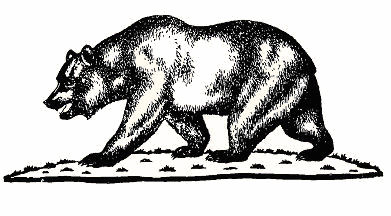
Sources...
Howe, Randy. Flags of the Fifty States and Their Incredible Histories: The Complete Guide to America's Most Powerful Symbols. Guilford, Conn: The Lyons Press, First edition, 2002.
"Bear on California Flag Faces a Face-Lifting Job." The Oakland Tribune 6 March 1953: Page 13.
Kelly, Allen. "Bears I Have Met--And Others." Project Gutenberg: Online Book Catalog. 2008. 16 March 2008
"Was it a Hog or a Dog?." The Los Angeles Times 3 August 1953: Page A4.
California Law. California State Legislature. 2008. 16 March 2008
Shearer, Benjamin F. and Barbara S. State Names, Seals, Flags and Symbols: A Historical Guide Third Edition, Revised and Expanded. Westport, Conn: Greenwood Press, 3 Sub edition, 2001.
Additional Information
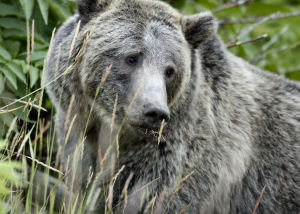
Grizzly Bear Ursus arctos horribilis
Photograph: USFWS photo by (Terry Tollefsbol)
California Grizzly Bear: Wikipedia: The free encyclopedia.
Grizzly bear (Ursus arctos horribilis): Species profile from the United States Fish and Wildlife Service.
Ursus arctos (Brown Bear, Grizzly Bear): Information about brown bears from the Smithsonian National Museum of Natural History.
Grizzly Bear - Ursus arctos horribilis: The Lewis and Clark Fort Mandan Foundation.
Bear in Mind: The California Grizzly at The Bancroft Library, University of California, Berkeley.
The Monarch Bear Institute: The story of Monarch, the California Grizzly Bear who lived in captivity for 22 years.
Grizzly Bear Exhibition: A little about California Grizzly Bears from the California Grizzly Bear Exhibition at the Valley Center History Museum.
Grizzly Bear Outreach Project: The Washington State Grizzly Bear Outreach Project is an independent project guided by community members and facilitated by Insight Wildlife Management and the Conservation Partnership Center. The project began in Okanogan County in 2002, and was expanded to encompass Whatcom and Skagit Counties in 2003.
Ursus arctos (Brown bear) Information and pictures from the University of Michigan Museum of Zoology's Animal Diversity Web..
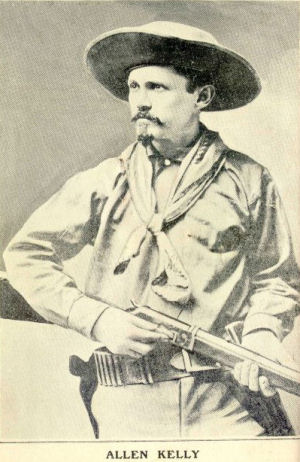
Allen Kelly: Front Plate
Bears I Have Met--And Others
Ursus arctos horribilis Grizzly Bear: Encyclopedia of Life.
Ursus arctos horribilis (Zimmermann, 1780) Ord, 1815: Integrated Taxonomic Information System (ITIS) Here you will find authoritative taxonomic information on plants, animals, fungi, and microbes of North America and the world.
Ursus arctos - Linnaeus, 1758 (Brown bear): Brown bear profile from NatureServe Explorer, an online encyclopedia of life.
State Animals: Complete list of official state Mammals from NETSTATE.COM.
More symbols & emblems: Complete list of official California state symbols from NETSTATE.COM.
Bears I Have Met--And Others, by Allen Kelley - Illustrations by Ernest Thompson Seton, W. H. Loomis, Homer Davenport, Walt. McDougall, Charles Nelan, W. Hofacker, Will. Chapin and the Author. Philadelphia, Drexel Biddle, Publisher, 1903. This is complete text of Allen Kelley's Bears I Have Met--And Others, published in 1903 and made available by Project Gutenberg.
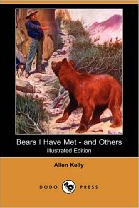
Bears I Have Met-and Others
by Allen Kelly
Bears I Have Met - and Others, by Allen Kelly, Illustrated by Ernest Thompson Seton, W. H. Loomis. 136 pages, Dodo Press (March 28, 2007) A collection of amusing stories about bears that were accumulated and written over a quarter of a century of wanderings and hunting on the Pacific Slope.
California Grizzly, by Tracy I. Storer, Lloyd P. Tevis, 335 pages, University of California Press; New Ed edition (December 27, 1996) The California Bear Flag and the University of California football team the Golden Bears emblemize the great animal that has been extinct in California since the 1920s but once numbered perhaps as many as ten thousand in the state. Forty years after its original publication, University of California Press proudly reissues California Grizzly, still the most comprehensive book on the bear's history in California. The lessons of the book resonate today as the issues of protection of wildlife habitat versus unfettered development of land for human use are debated with increasing urgency.
Where the Grizzly Walks: The Future of the Great Bear, by Bill Schneider, 302 pages, Falcon; First edition (December 1, 2003) Admired for its majesty and often feared for its strength, speed, and supposed aggressiveness, the grizzly bear was once unchallenged as the great apex predator of the American West. But by the 1970s, hunting and habitat loss had reduced its numbers in the lower 48 states to a mere 800 animals occupying just two percent of the bear's former range. Where the Grizzly Walks assesses the bear's current status and its uncertain future at the beginning of the 21st century.
Growing Up Grizzly: The True Story of Baylee and Her Cubs, by Amy Shapira, Douglas H. Chadwick. Reading level: Ages 4-8, 48 pages, Falcon; First edition (February 1, 2007) Follow the true story of a young bear all alone in the Alaskan wilderness and the big-hearted grizzly family that embraced him as their own.
